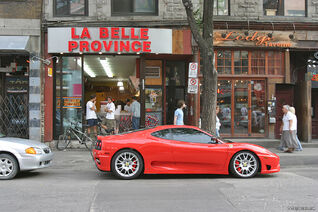
At the 2003 Geneva Auto Show, Ferrari released an upgrade package for their 360 Modena. Since that time, the Challenge Stradale option has been a must for customers buying a 360 late in the production line.
So what does the extra $46 000 USD bring to the table? It is first necessary to take a look at the exceptional automobile upon which this car is based. Having an all-aluminum monocoque and a flat-plane V8 whipping out 395 bhp, the 360 Modena has raised Ferrari's standards from the preceding F355 that came before it. With these elements, and Pininfarina's timeless styling, it was foolishly easy to call the 360 the perfect sports car. And many publications did just that.
Like the dual purpose road / race Ferraris of the sixties, the 360 has benefited from diverse motor sport programs. Considering that 300 examples have been racing in a Challenge program since 2001, and Ferrari's factory GT Endurance model debuted late the same year, the series has been benefiting from hours of track time. These cars have motivated Ferrari to offer their developments in the road-going 360 Challenge Stradale.
Challenge Stradale[]
Outwardly, only subtle differences differentiate the Challenge Stradale from other 360s. Don't let aesthetics fool anyone, the Challenge Stradale is comprehensively upgraded to include only proven performance enhancements. One of Patrizio Moruzzi's design goals was to reduce three seconds off the 360's Fiorano lap record. He and his team succeeded.
The huge performance gains can largely by attributed to increase in power and a reduction in weight. Ferrari put the 360 on a titanium and carbon fiber diet which shed 243 lbs (110 kgs) off the car.
Passengers are easily reminded off the Stradale's weight through a reduced interior which features no carpeting, rubber floor mars and carbon fiber seats finished in leather or fire-resistant fabric. The rest of interior is purpose-built, with a bright yellow tach highlighting the Alcantrara trimmed dash. For the more hardcore enthusiast, appointments can include four-point racing harnesses, a roll bar or lexan sliding widows to replace the electric counterparts. Air conditioning is a standard feature and is one of the only compromises to help the sale-ability of the car.
Weight and aesthetics aside, the Stradale does everything a lot faster than before: reaches sixty in 4.1 seconds, stops with the Enzo's carbon brakes and changes gears in 150 milliseconds.
Fine tuning is how the engineers at Ferrari extract more power from the 3.6 liter V8. More horsepower is realized through a high-compression combustion chambers, polished ports, and a larger intake tract. Attached is a dual-flow exhaust which, by means of a valve, can bypass most of the deadening for a blaring symphony of noise. This wail is distinctive of the Stradale.
A six speed semi-automatic transmission comes standard on all Stradales. It works in conjunction with the onboard computer which s largely invisible from the cockpit. To maintain different levels of comfort the Stradale can be switched to sport or race modes. When race mode is selected, the transmission halves it shift time to150 milliseconds, but the shifting is less comfortable and more lumpy.
The Stradale sits lower than other 360s thanks to stiffer titanium springs. Computer controlled damping is adjustable and changes with the various driving modes. Also adjustable is the level of traction control which can be turned off.
Aerodynamics played a large role in the Stradale's development. By extending the front lips and reshaping the rear deck lid as well as the side profile this car generates more down force than the standard model. With its entirely new carbon fiber under tray, the Stradale offers a substantial increase in down force above 100 mph. This down force comes at no extra cost as drag remained constant during development.
Conclusion[]
The Challenge Stradale is much more than a redressed 360 with extra power. It is a welcomed conclusion to a series which has benefited from Ferrari Challenge and FIA GT events. Its bare-bones approach and subtle styling changes only hint at the thoroughbred under the skin: this is a road-legal car that is entirely race-ready and at home on track.